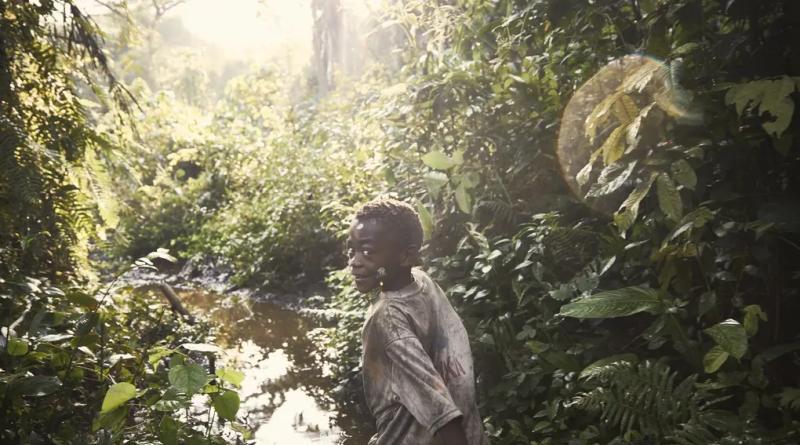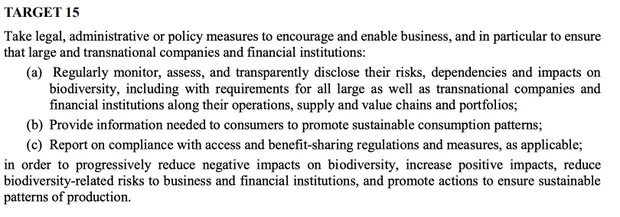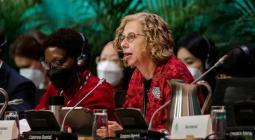Cop15 in Montreal: did the summit deliver for the natural world?

The talking is over, and a text has been agreed on the next decade of targets to save the natural world. Here are the highs and lows of the Convention of Biological Diversity’s (CBD) agreement
Conservation of species
The term “nature positive”, which scientists had said would be the biodiversity equivalent of “net zero”, did not make the final document. Many will see this as a missed opportunity – a unifying idea similar to keeping global heating to within 1.5C. However, the 2030 goal to “take urgent action to halt and reverse biodiversity loss” is still considered a relatively strong call to action.

Photograph: UNEP
Many 2030 milestones were removed from the initial text, but then added in the early hours before the final agreement. This includes a goal to reduce extinction risk by 2030, which was missing from the earlier draft. Stuart Butchart, the chief scientist at BirdLife International, said: “The commitment to significantly reduce extinction risk by 2030 was an important and very welcome late reinsertion, though we would have liked to have seen a quantitative target here as for other targets.”
For example, the risk of species going extinct should be reduced by 20% overall by 2030 in order to meet the stated goal of reducing the rate extinctions tenfold by 2050, he says.
There is no 2030 target for increasing species populations abundance. Some earlier drafts included details about enlarging the area of natural ecosystems by at least 5% by 2030, and these targets were removed.
Without such numbers to aim for it is harder to assess and make countries accountable in the short-term, but specific commitments becoming more general is inevitable when seeking compromise with so many countries.
Lots of researchers and scientists think these details are a big miss – although country delegates seem less concerned. “It’s taking us in the right direction but there is a lack of quantification which means it’s hard to hold governments to account,” said Butchart.
The 30x30 target
Many feel the success of the conference hangs on the headline target of protecting 30% of land and sea by 2030. Lots of countries came to the conference saying achieving this was their priority – there were even posters about it in the airport.

The final wording on this has been widely hailed as a success. It is a global target, meaning that the most biodiverse countries will be protecting key areas such as the tropical forests of the Amazon, the Congo basin and Indonesia. Currently, 17% of terrestrial and 10% of marine areas are protected so this is a significant increase, although some groups – including those inspired by EO Wilson’s Half-Earth project – say the text should have pushed for 50%.
Indigenous rights
The main criticism of 30x30 (and other area-based conservation targets) is that implementing them risks violating human rights. This is because of associations with “fortress conservation”, where people who had been stewards of natural spaces for thousands of years were removed by westerners who felt that nature should be separate from humans to be truly wild. It’s a sensitive issue, and lots of the area-based conservation targets in the text were opposed because of these concerns.
Generally, however, the wording on the protection of Indigenous rights and territories was welcomed. It was emphasised throughout the 23 targets and four goals that make up the main agreement. The framework reaffirms the rights of Indigenous peoples and ensures they have a voice in any decision-making. Concerns remain that this may not affect how Indigenous peoples are treated on the ground, but coming up with a strong text was considered important.
Lucy Mulenkei from Kenya, the co-chair of the International Indigenous Forum on Biodiversity (IIFB), said: “Indigenous peoples and local communities are happy that finally we are here. With most of the recommendations that we had submitted and negotiated already reflected we leave Montreal happy and ready for the implementation journey. We are glad we never gave up even when times were tough.”
Restoring degraded land
This target suggests restoring 30% of degraded lands. The text went with a more ambitious target of 30%, instead of 20%, which “is really good and ambitious and necessary”, a delegate from a European country told Reuters. “We were surprised that [the text] is actually capturing most of the things we want to go for,” he added.
Subsidies
At least $1.8tn (£1.48tn) of environmentally harmful subsidies is financing the annihilation of wildlife every year, research shows. This money goes to activities such as high-emission cattle production, forest destruction and pollution from synthetic fertilisers. The failure to remove these subsidies was one of the 20 Aichi biodiversity targets governments failed to meet during the past decade. Redirecting subsidies to support activities such as storing carbon in soil, producing healthier food and growing trees is a huge opportunity.
The final text says harmful subsidies should be reduced by at least $500bn a year by the end of the decade. It does not specify whether they should be eliminated, phased out or reformed, but this is recognised as one of the strongest parts of the agreement.
Finance
Always one of the most contentious areas, finance issues led to delegates from 70 African, South American and Asian countries walking out of negotiations for several hours on Wednesday. In the end it achieved the crucial financial target of $200bn a year from all sources – including public and private sectors – for conservation initiatives, though it demands less from wealthy countries than some developing states had wanted. This target is seen as critical for the successful implementation of any deal.
Developing countries were pushing for $100bn a year to flow from wealthy countries to poorer nations. However, the text mentions only that $20bn – to $30bn a year comes from developed countries by 2030.
The money could come voluntarily from any country – a nod to the developed nations’ desire that countries with large economies, such as China, also contribute. Asked whether China should be considered a developing country, as still defined by the World Bank, the EU commissioner Virginijus Sinkevičius said: “I think we should not stick to 1992 descriptions but see the reality on the ground, and it’s very different from 1992.”
One of the greatest points of contention was whether a new fund should be established for biodiversity. Developing countries such as the Democratic Republic of the Congo, Brazil and Malaysia expressed disappointment that a new, separate fund was not set up.
Digital sequence information
Digital sequence information (DSI) is a policy term referring to the use of genetic sequence data. DSI is derived from the natural world – such as microorganisms, fungi, flora and fauna. It is used to drive breakthroughs in medicine and science, including the creation of Covid-19 tests, vaccines and new cancer drugs, as well as biofuels, crop improvements and research. There are many discoveries yet to be made.

Many of the countries in the global south have the most biodiversity, meaning they, in theory, would contribute the most to DSI. The African Group, Latin America and Caribbean Group (Grulac) and the Asia and Pacific Group have said it is unfair that pharmaceutical companies make huge revenues from creating products and yet they see no benefits.
Cop15 has decided to create a multilateral benefit-sharing mechanism so these countries are rewarded. It would be impractical to create bilateral contracts every time DSI is used because researchers work on many sequences at the same time. A multilateral system would see data being added under certain licences, so if researchers and companies create something of value any revenues that result are shared.
Details will be worked out in the coming years, but the decision to create benefit-sharing from DSI is important. “This compromise was instrumental in reaching broader agreement on the global biodiversity framework,” said Bob Kreiken, a researcher in DSI at Delft University of Technology. “It is the outcome of a cooperative and compromising spirit of the parties and stakeholders involved.”
Pesticides
Risks from pesticides and highly hazardous chemicals would be reduced by at least half. However, the text does not address slashing their overall use. Many argue it is the use of pesticides that should be reduced, not the risk from pesticides. Language on plastic pollution has also been watered down – the final text says countries should be “working towards eliminating plastic pollution”, without any quantifiable targets.
Businesses and consumption
Businesses should also be asked to assess and disclose how they effect and are affected by nature loss, but the document does not make such reporting mandatory. The text encourages policymakers to “encourage and enable” businesses to monitor and assess and disclose their impacts on biodiversity, but the absence of the word “mandatory” is considered a weakening of this target.

It’s a widely held belief that many countries and financial firms would move towards mandatory disclosures anyway. Tony Goldner, who heads a group working on a framework for companies to manage and disclose economic risks related to nature, said: “At an institutional level, the train has left the station in any case because financial institutions are increasingly aware that nature risk is sitting on their balance sheets.”
The use of the language “ensure that large business and financial institutions” creates an obligation on governments to require companies to comply, say the target’s architects.
Many felt there was as a watering down of ambitions on consumption and production, key drivers of biodiversity loss. Previous drafts included a clear ambition to halve the footprint of production and consumption but this was removed, and replaced with a vague commitment by 2030 to “reduce the footprint” with additionalwoolly words such as “substantially” and “significantly”.
There is no mention of the need for dietary change in the text. Huge reductions in meat-eating are essential to avoid the dangers of the climate crisis, and in western countries, beef consumption needs to fall by 90%, research shows.
Reporting and monitoring
The CBD has a history of failure. The world collectively failed to meet a single one of the targets agreed in 2010 in Aichi. It was the second consecutive decade that governments have fallen short of meeting targets.
To prevent a repeat, states have agreed on a monitoring framework that should allow them to regularly evaluate progress and to further be specified in Cop16 in Turkey at the end of 2024.
“While this might seem like a solid plan, there are no binding commitments making the whole mechanism quite weak,” said Dr Imma Oliveras Menor from the Environmental Change Institute at the University of Oxford. “The goals and targets adopted are a great step forward, but many fail at being too broad therefore their implementation will be complex.”
Find more age of extinction coverage here, and follow biodiversity reporters Phoebe Weston and Patrick Greenfield on Twitter for all the latest news and features
cover photo: An Mbuti Indigenous boy runs through the Ituri rainforest in the Democratic Republic of the Congo. The wording on the protection of Indigenous rights and territories in the agreement was largely welcomed. Photograph: Hugh Kinsella Cunningham/EPA





